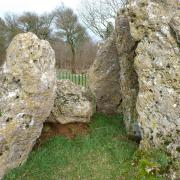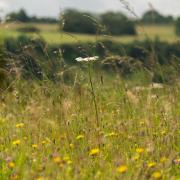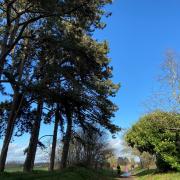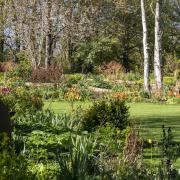Less than an hour from Gloucestershire airport, Jersey is a serene blend of France and England and is a perfect holiday destination.Words and photography by Lucy Jenkins
Claude Debussy wrote 'La Mer' inspired by Jersey's principal southern coast, St Aubin's and there are 45 miles of coastline, ranging from golden sands and tranquil coves to dramatic jagged cliffs rising steeply from the foaming sea.
Jersey is the southernmost Channel Island and has the best sunshine record in the British Isles, and situated only 14 miles from the Normandy coast is a serene blend between French and English. All road names are in French and there is a maximum speed limit of 40mph around the entire island which gives it a relaxed and unhurried air. French was the official language in fact, until the 1960s and even though English is the main tongue, Jrriais (a form of Normandy French) is still spoken by the locals in the more rural parts of Jersey. Scattered about the countryside are remnants of the French occupation during the War of the Roses; ruined Normandy farmhouses and forts which are great fun to explore and some forts have even been converted into holiday accommodation. In all other respects however, Jersey remains resoundingly English. The capital St Helier is a pleasant, bustling town of squares and pedestrianised streets where shopping is made more attractive by the fact that the Channel Islands have low rates of duty and no V.A.T.
It is easy to feel as if properly on holiday here, even though it takes less than one hour from Gloucestershire airport. The weather was noticeably different; the sky was blue and the temperature warm whereas back in England, it was strictly not t-shirt weather. The tourism board website www.jersey.com notes that in the summer, temperatures rarely stray below 20 degrees Celsius. Tidy, green fields meet the narrow, winding lanes where the sea glitters beyond and butterflies dance above bright flowers. Every now and then, resting in the shade is the Jersey cow - one of the defining images of Jersey, calm, caramel coloured and liquid eyed.
Jersey is well-known for its cuisine: A saying that is often heard is, "Everything tastes better in Jersey." Certainly, Jersey for its small size (9 miles by 5) has an astounding 192 restaurants, ranging from small coastal caf�s championing the best of local farm produce to gastronomic Michelin starred quayside restaurants which serve up the most extravagant seafood dishes.
Situated in the St Mary region in the north, La Mare is a wine estate with over 20 acres of vineyards. The main farmhouse built from the pink granite for which Jersey is famous for dates back to 1792 but other buildings go back further to the 1600s where there are also extensive kitchen gardens that still yield delicious produce such as jams, preserves, mustards and fudge.
The acres and acres of apple orchards are where 100,000 tonnes of apples are crushed to produce cider and Jersey's famous Apple Brandy and Cream Liqueur (a delicious but lethal tipple made from Apple Brandy and Jersey cream). However, it's the wine that La Mare is more known for with over 40,000 bottles being produced every year. Visitors can visit the winery and learn how La Mare produces its wines from grape picking to bottling and afterwards sit on the terrace overlooking the vineyards, and sample the locally produced food from their new restaurant. Dishes range from simple cheese ploughman's to a Director's lunch complete with a half lobster and a startling array of baby gambas, shrimp, crayfish and scallops.
Jersey is very concerned with local produce, with a heavy emphasis on fresh seafood. The Boat House restaurant in St Aubin's village is a modern glass and timber building situated right on the harbour with views out towards the crescent shaped bay which devotes itself to offering simple Sunday lunches to an la carte dinner menu with fresh oysters and seared scallops. Teamed up with a bottle of wine or champagne from their extensive list, it'd be hard to leave once the sun sets over the bay and the restaurant dims its lights.
For those visitors who are more into country-pub-and-a-pint-fare, then a gastropub with a magnificent view of the 13th century Mont Orgueil castle is definitely worth a visit, especially as it's situated opposite Gorey Bay, a long stretch of unspoilt sand. Castle Green is a lovely country pub, with a great terrace which captures the last of the afternoon sun. It's a particular favourite of ramblers and walkers who, after scrambling up the coastal paths and walked around the ramparts of Mont Orgueil, are looking for an inexpensive, hearty pub lunch with a pint of Jersey's local cider.
Due to Jersey's situation of being a small island just off the Normandy coast, it has long been used as a battleground between combating countries. The last invasion was by the Germans in World War II who used POWs and skilled labourers to build Hohlgangsanlage 8 or HO8, an underground hospital complex in St Lawrence, Jersey. The kilometre of tunnels themselves tell of Jersey life under Occupied rule and are dark, surprisingly warm at 17c with a rather ominous feel to them. Good for history enthusiasts and for those who often wonder how the Channel Islands coped during the war.
A good family visit would be to go to the Durrell Wildlife Conservation Trust, in Trinity founded over 50 years ago where the famous naturalist Gerald Durrell who dedicated his life to saving rare species of animal has his headquarters. Over 130 endangered species are here, including gorillas, lemurs, orang-utans and the lesser known Mallorcan midwife toad. Durrell's vision was to help endangered species recover and survive in the long-term and often said, 'If you want to know my ambition, it's to close the Trust and the zoo down because they won't be neccessary anymore. It would be marvellous to think that one day that could happen.' Although there's obviously still a way to go, the Trust has set up links with local communities around the world which are intent on saving the last of several species of animals.
Of course, it is perfectly possible to not do anything in Jersey apart from explore the many bays and inlets and laze on the beaches. What is unique about Jersey is the sheer expanse of sandy coasts which are largely quiet and remote and are only a few miles from the towns and villages. Driving back to the airport, it was getting towards 5pm but families were still on the beaches, playing with leaping dogs and staggering toddlers. Elsewhere, couples wrapped in blankets just sat and watched the gentle waves roll in to meet the golden sand.
Having that on your doorstep every day is surely preferable to cocktails even in the most expensive bar.
Getting there: Manx2 has launched new flights from Gloucestershire airport in Staverton, available Friday afternoon with return flights on Sunday. Prices start from �49.99 one-way. For more information, please visit Gloucestershire Airport's website www.gloucestershireairport.co.uk or the Manx2 website, www.manx2.com
Staying there: The Grand is a luxury hotel, situated in the middle of St. Helier making it an ideal base from which to explore the island. The hotel includes a new champagne bar, an Albert Roux restaurant and a New York style brasserie. Many of the rooms have superb sea views. Visit www.grandjersey.com
The tourism website www.jersey.com also has an extensive accommodation guide from hotels to self catering apartments with many last minute deals with prices being as low as �25 pppn.
Some forts built in the 18th and 19th centuries against French invasion are now available as self catering holiday lets. Due to their prominent position on cliffs and headlands, they often have the best views possible in Jersey and are perfect for groups of four or more. www.jerseyheritagetrust.org has some more details on which ones are available.
Being there: There a number of annual festivals throughout the year which centre around Jersey's excellent local produce and many outdoor activities such as coastal walks and water sports which will appeal to the more active. www.jersey.com has full details.


























